Peer-Reviewed Paper by Prominent Scientists Reinforces Need for Hand Washing,
Warns that Wearing Glasses / Spectacles Does Not Reduce Risk of Infection
WATERLOO, Ontario, April 13, 2020—Moving swiftly to address and correct harmful myths and misinformation, a new peer-reviewed paper from five of the world’s most prominent ocular scientists reassures contact lens wearers during the global COVID-19 / coronavirus pandemic. Published in Contact Lens & Anterior Eye, “The COVID-19 Pandemic: Important Considerations for Contact Lens Practitioners” offers five important facts for anyone who relies on contact lenses or eyeglasses / spectacles:
-
- You Can Keep Wearing Contact Lenses. There is currently no scientific evidence that contact lens wearers have an increased risk of contracting COVID-19 compared with glasses / spectacles wearers. Consult your eye care practitioner with questions.
- Good Hygiene Habits are Critical. Thorough handwashing and drying are essential, as well as properly wearing and caring for contact lenses, ensuring good contact lens case hygiene, and regularly cleaning glasses / spectacles with soap and water. These habits can help you stay healthy and out of your doctor’s office or hospital.
- Regular Eyeglasses / Spectacles Do Not Provide Protection. No scientific evidence supports rumors that everyday eyeglasses / spectacles offer protection against COVID-19.
- Keep Unwashed Hands Away from Your Face. Whether you wear contact lenses, glasses / spectacles or require no vision correction at all, avoid touching your nose, mouth and eyes with unwashed hands, consistent with World Health Organization (WHO) and S. Centers for Disease Control and Prevention (CDC) recommendations.
- If You Are Sick, Temporarily Stop Wearing Contact Lenses. Contact lens wearers who are ill should temporarily revert to wearing eyeglasses / spectacles. You can resume use with fresh, new contact lenses and lens cases once you return to full health and have spoken with your eye care practitioner.
On April 8, the CDC issued updated guidance on contact lens wear during the COVID-19 pandemic, further supporting key findings from the Contact Lens & Anterior Eye paper. The CDC also points out that personal eyeglasses and contact lenses do not qualify as personal protective equipment (PPE).
“Millions of people are asking how COVID-19 affects eye care, especially since approximately two out of every three adults worldwide wear contact lenses, spectacles or eyeglasses. Unfortunately, misinformation has become widespread in recent days. Our goal is to make sure that science-backed truths are understood and shared, replacing fear with fact,” said Dr. Lyndon Jones, director of the Centre for Ocular Research & Education (CORE) at the University of Waterloo (Ontario, Canada) and the paper’s lead author. “Our findings indicate that contact lenses remain a perfectly acceptable form of vision correction during the coronavirus pandemic, as long as people practice good hand hygiene and follow appropriate wear-and-care directions.”
The complete paper incorporates findings from more than 100 referenced sources. It delves into multiple aspects of ocular health amidst the pandemic, including practical advice for eye care professionals. The paper and other resources for good wear and care can be downloaded from COVIDEyeFacts.org.
This new research-based review complements and significantly expands on CORE advisories regarding handwashing and safe contact lens wear issued in mid-March 2020.
Dr. Jones is a preeminent authority on eye care, having authored more than 400 refereed and professional papers and delivered more than 1,000 lectures worldwide in over 40 countries. In 2019, he was named by Expertscape as the most published expert in the field of contact lens research.
Joining him to author the COVID-19 paper were four globally respected researchers, educators and clinicians: Dr. Karen Walsh, professional education team leader and clinical scientist at CORE, Dr. Mark Willcox, director of research at the School of Optometry and Vision Science at UNSW (Sydney), Dr. Philip Morgan, director of Eurolens Research at the University of Manchester (United Kingdom), and Dr. Jason Nichols, associate vice president for research and Professor at the University of Alabama at Birmingham School of Optometry (United States) and editor-in-chief of Contact Lens Spectrum.
About CORE
The Centre for Ocular Research & Education (CORE) was established in 1988 at the University of Waterloo’s School of Optometry & Vision Science. Over the next three decades, the organization evolved from a three-person operation into a thriving hub of basic and applied research, collaborating with sponsors, agencies and academia on advanced biosciences, clinical research and education. Its uncompromising independence and results of the highest quality have been at the heart of many of the most prominent advances in eye health. Today, its 50-person team serves a range of ophthalmic sectors, including medical devices, ocular pharmaceuticals, digital technology and others, with a focus on the anterior segment. For more information, please visit core.uwaterloo.ca.
MEDIA CONTACTS
Aimee J. Lewis
McDougall Communications for CORE
aimee@mcdougallpr.com +1-585-414-9838 (mobile)
Mike McDougall, APR, Fellow PRSA
McDougall Communications for CORE
mike@mcdougallpr.com or +1-585-545-1815 (mobile)






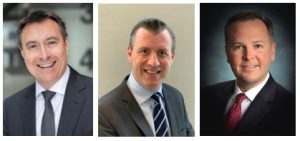
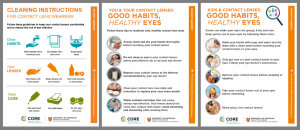
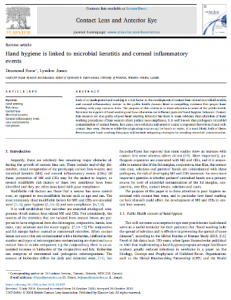 A recent literature review from Professor Emeritus Desmond Fonn and the
A recent literature review from Professor Emeritus Desmond Fonn and the 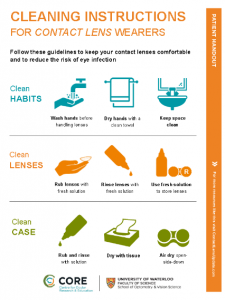 The paper notes that in line with its ability to reduce the spread of disease, careful and thorough hand washing with soap and water followed by hand drying with unused paper towels should greatly reduce the transfer of microbial contamination from hands to the contact lens or eye. Clean hands plus use of daily disposables results in the lowest risk of contact lens-related complications. For wearers of reusable lenses there are additional guidelines on lens and case cleaning which can be
The paper notes that in line with its ability to reduce the spread of disease, careful and thorough hand washing with soap and water followed by hand drying with unused paper towels should greatly reduce the transfer of microbial contamination from hands to the contact lens or eye. Clean hands plus use of daily disposables results in the lowest risk of contact lens-related complications. For wearers of reusable lenses there are additional guidelines on lens and case cleaning which can be  hands. Unwashed hands were pressed into agar (Figure 2a), and also used to handle a new contact lens (Figure 2b). Scientists then repeated the procedure after following recommended handwashing practices, touching both the agar directly, along with applying and removing a contact lens (Figures 2c and 2d). The results clearly demonstrate the impact handling has on contact lenses. Samples that had been touched with unwashed hands showed significantly higher numbers of visible bacteria. By comparison, the contact lens touched with clean hands had only a minimal bacterial load.
hands. Unwashed hands were pressed into agar (Figure 2a), and also used to handle a new contact lens (Figure 2b). Scientists then repeated the procedure after following recommended handwashing practices, touching both the agar directly, along with applying and removing a contact lens (Figures 2c and 2d). The results clearly demonstrate the impact handling has on contact lenses. Samples that had been touched with unwashed hands showed significantly higher numbers of visible bacteria. By comparison, the contact lens touched with clean hands had only a minimal bacterial load.


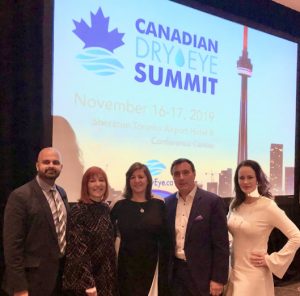 “Clinical management of dry eye disease is front of mind for many practitioners as they explore building and expanding their contemporary evidence-based practice,” said Karen Walsh, CORE clinical scientist and Contact Lens Update editor. “We’re excited to bring the best of the Canadian Dry Eye Summit to professionals around the world through our newest issue.”
“Clinical management of dry eye disease is front of mind for many practitioners as they explore building and expanding their contemporary evidence-based practice,” said Karen Walsh, CORE clinical scientist and Contact Lens Update editor. “We’re excited to bring the best of the Canadian Dry Eye Summit to professionals around the world through our newest issue.” Key observations from the speakers are summarized in the
Key observations from the speakers are summarized in the  Paul Gifford, the noted Australian optometrist and research scientist specializing in ortho-K and myopia control, was invited by CORE to curate the special edition. His
Paul Gifford, the noted Australian optometrist and research scientist specializing in ortho-K and myopia control, was invited by CORE to curate the special edition. His 